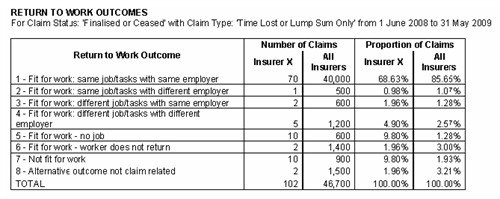Return to work outcomes
This data management bulletin assists insurers with coding of return to work outcomes and the intent of the data usage.
The requirement to report the return to work outcome is specified within the Workers' compensation insurers' interface data specifications (PDF, 1.7 MB) for the monthly insurer interface as per 4.2.29 – Return to work status.
Business practice and guidance notes
During a claim lifecycle, claims may be characterised by multiple return to work stages. The intention of recording a return to work outcome is to identify the return to work status at the finalisation of a statutory claim, i.e. where the claim status is 'finalised', 'ceased' or 'rejected' and weekly compensation has been paid. This enables additional reporting to consider cost and claim duration against the type of return to work outcome.
The return to work outcome must not be limited to the medical certification at finalised of the statutory claim and consideration should be given to the workers actual capacity for work with their employer.
To assist insurers with indicating an appropriate return to work outcome, the following questions should be considered:
- Is the worker fit for work (either RTW codes 01 to 06)?
- Is the worker fit for work and has returned to work in any capacity (either RTW codes 01 to 04)?
- Is the worker fit for work but does not return or does not have a job to return (either RTW codes 05 or 06)?
- Is the worker not fit for work (RTW code 07)?
- Has the worker deceased (RTW code 08)?
Coding and code descriptions
Below is a list of return to work outcomes as required for reporting to the Workers' Compensation Regulator via the monthly insurers' interface data specification. A description is provided to assist with determining the appropriate return to work outcome code.
01 – Fit for work: same job/tasks with same employer
The injured worker has returned to the same job or tasks with the same employer.
02 – Fit for work: same job/tasks with different employer
The injured worker has returned to the same job or tasks with a different employer.
03 – Fit for work: different job/tasks with same employer
The injured worker has returned to a different job or the tasks involved have been modified with the same employer.
04 – Fit for work: different job/tasks with different employer
The injured worker has returned to a different job or the tasks involved have been modified with a different employer.
05 – Fit for work: no job
The injured worker is fit for work but is unable to return to work because there is no job available. Examples of this situation include:
- termination
- redundancy
- seasonal employment
06 – Fit for work: worker does not return
The injured worker is fit for work but has voluntarily decided not to return to work. Examples of this situation include:
- resignation
- abandonment of employment
- extended leave
- moved interstate/overseas
- retirement
07 – Not fit for work
The injured worker is not fit for work when entitlement to weekly payments of compensation stops.
08 – Alternative outcome
The injured worker has died.
Reporting requirements
As per the insurers' interface data specification, the return to work outcome must be supplied if:
- The claim has the claim status of either 'finalised', 'ceased' or 'rejected' (status is 'FIN', 'CSD' or 'REJ').
Example – using return to work outcomes in reporting
Where the claim has been reopened and multiple return to work outcomes have been provided, only the outcome for the last finalisation is used for scheme reporting. The return to work outcome at claim finalisation does not represent a level of durable return to work.
Below is an example of the Monthly self-insurer report – Return to work outcomes table. Within this table, a count of claims per return to work outcome code is provided and measured as a percentage against the claims for the insurer and across the scheme.

For more information
Email Data and Evaluation Services on oirdata@oir.qld.gov.au